Big bang and evolution of early universe
First let us go to the beginning, there is supposed to be a beginning, though there is no need to have a beginning. Generally accepted theory is, in the beginning, there is nothing. This nothingness, a formless energy starts to vibrate. Honestly no one knows how this mighty creation happened from nothingness. Because, we don’t have an answer and we cannot exist without an answer we made up different explanations, theories and poems. One such theory, widely accepted is, The Big –bang. Let us assume that is the way the Universe is created. There is no harm whether it is true or false but at least we can draw some sequential events on the time scale within the purview space – time dimension.
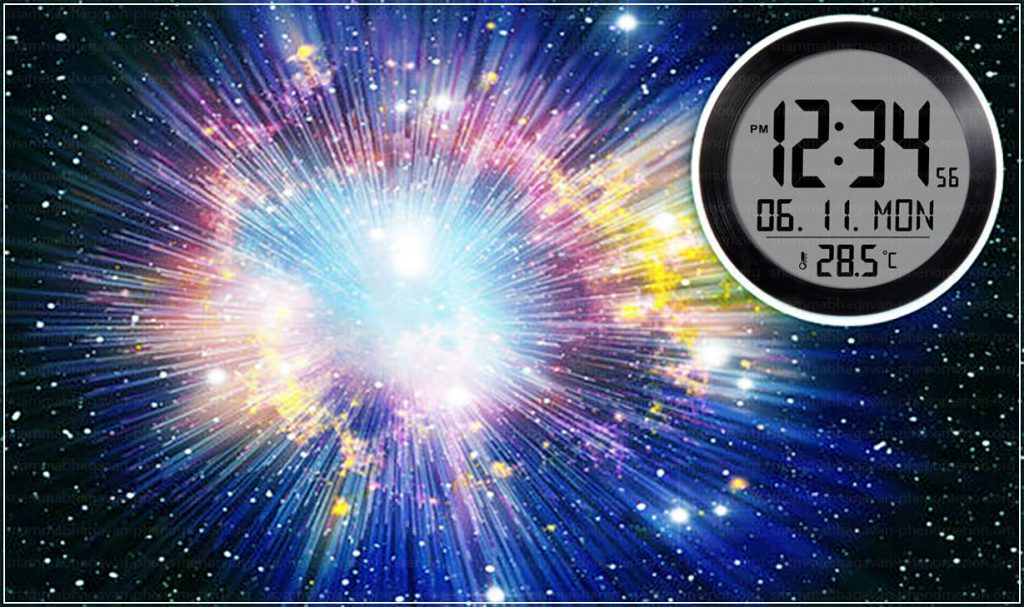
Scientific models of the early universe are highly speculative. Below figure shows a sketch of one possible timeline of events, just after the cosmic inflation, cosmologists believe that all matter in the universe was squeezed into a space much smaller than an atom before this inflation or big bang.
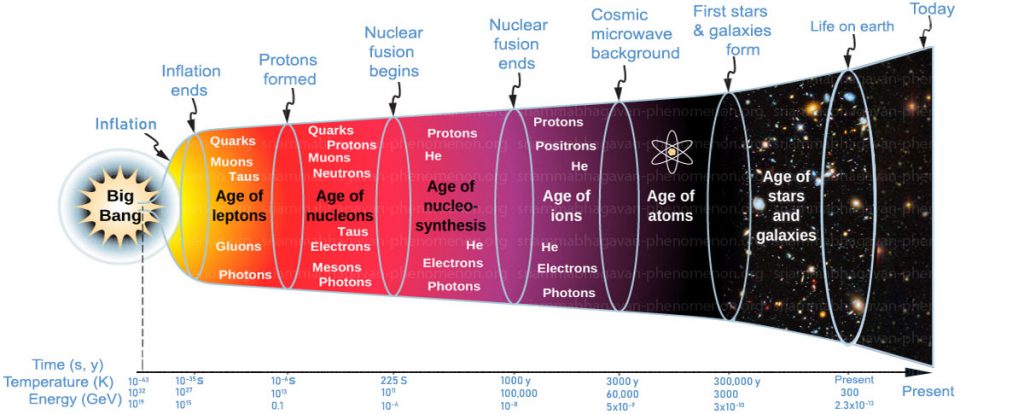
Our universe is approximately 13.6 billion years old. After the big bang, the Universe spent almost two thirds of this time creating nebulas, clusters and galaxies. Around 4.6 Billion years ago, our solar system was cooked in a nebula or molecular clouds. Our solar system took another few million years to create various planets. Hydrogen and helium constitute about ninety nine percent of solar systems as of today. Fusion reactions are still occurring under great pressure and temperatures, and this is the place where higher elements are cooked. Under these conditions, protons and neutrons came together to form helium atoms, carbon atoms, oxygen atoms and so on. Further heavier atoms are being formed through the stellar nucleosynthesis process. While this process is continuously happening even today, our mother earth came into(into) existence around 4.5 billion years ago. Life on this planet has originated millions of years ago. Known history is only the tip of an iceberg; the human race is just a few million years old.
Looking at the bigger picture on the evolution of our Universe, the best way of representation is found in Mayan Calendar (at least theoretically looks logical) deciphered by Carl Johan Calleman. Leaving aside the accuracy and conflicting views about the end of the world in 2012 and so on, Mayan calendar explains a metaphor of whole creation starting from big bang to the year 2012. This calendar describes the sequence of energies that describes the process within creation in one to thirteen steps from seed to fruit. There are nine such different processes reflecting nine levels, the greatest contribution to realizing and understanding that there is a divine plan of creation comes through Mayan calendar. Mayan calendar describes the evolution of consciousness and cosmic, biological, historical evolution.
Mayan Calendar
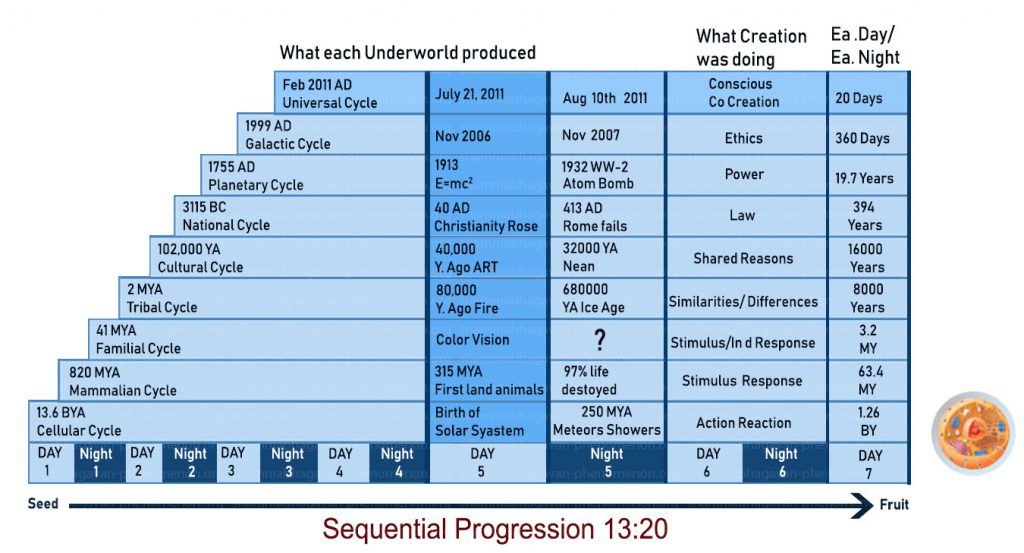
The Nine underworlds are major creation cycles where there is a process of 13 steps of development from seed to fruit. The lower underworlds reveal the evolution of consciousness manifesting in physical ways, such as a galactic matter and biological species. There are different frames of consciousness expanding from cellular to universal.
As the picture shows what each underworld produced, it can be understood that 1-Cellular, 2-Mammalian, 3- Familial, 4-Tribal, 5-Cultural, 6-National, 7-Planetary, 8-Galactic, 9-Universal, these nine waves correspond to levels of consciousness, throughout the evolution of universe. They have been activated in a sequential manner and have added new possibilities to humanity at these particular points in time.
Each level of the nine-level pyramid is developed by a wave with a frequency 20 times higher than its previous level. The factor 13 is seen in 13 heavens at the bottom of the pyramid. The factor 20 becomes evident in the difference between each successive underworld. Note that each successive underworld is 20 times shorter and this 13: 20 ratio is the one, which creates the entire fabric of the universe.
As we see from above, most of the time evolution is spent preparing biological life from single bacteria to multicellular cells and organisms like a human, society and early civilizations. If the evolution of life were compared to a day, then humanity is supposed to have emerged in the last few moments.
Human evolution
Depending on what and whom you believe, there are mainly two theories on how humans may have evolved. However, neither of them proved what is right or wrong or there is no consensus across the scientists. According to evolution theorists, around 350 million years ago, life came out of oceans in the form of amphibians and mammals form on earth, and then around 65 million years ago in the form of dinosaurs to monkeys to apes to chimpanzees. Further global cooling between 5-6 million years ago saw savannahs replacing the tropical forests of sub-Saharan Africa. The appearance of this new environment was in turn matched by an evolutionary pulse that gave rise to new carnivores and omnivores. Among them were hominines, the ancestors of modern man.
Most of the earth’s history is Pre-Cambrian where there are no fossil records and very little time is Phanerozoic, where our geologists have documented timing of major evolutionary events and very nicely depicted in the International Chronostratigraphic chart.
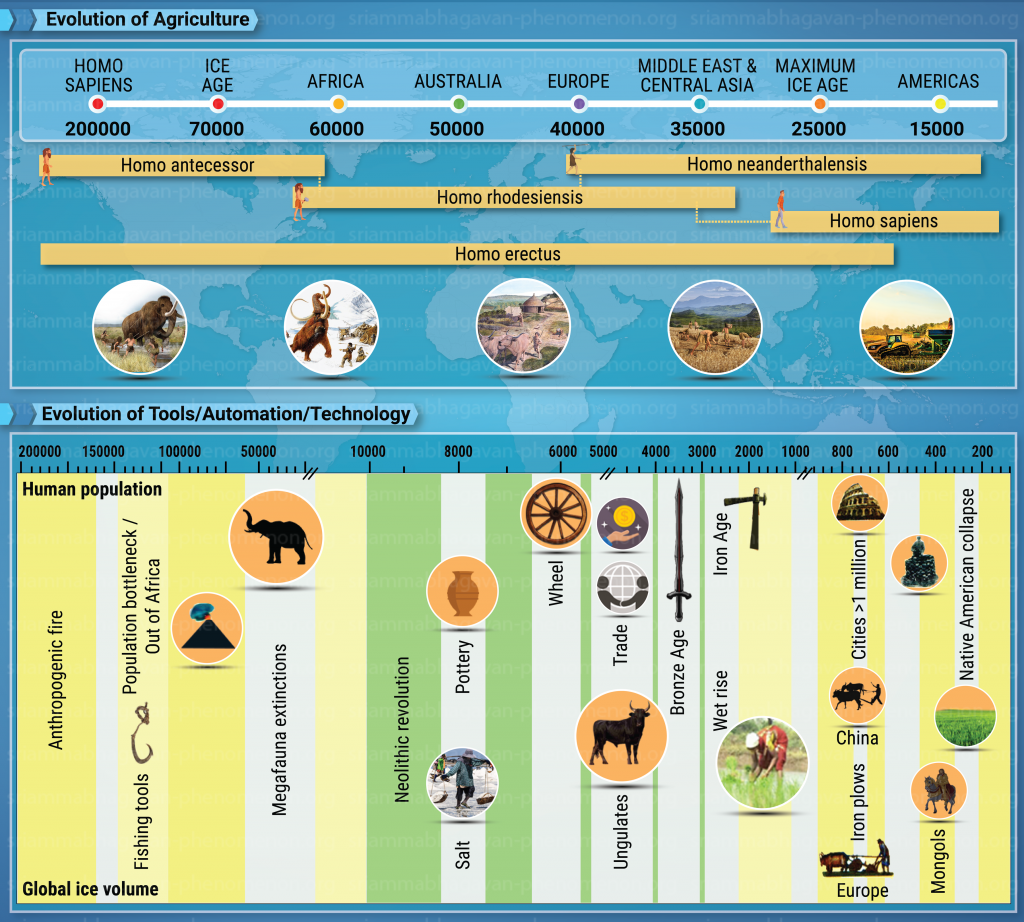
By about 5 million years ago certain apes in Africa had mastered the art of upright walking – these were the hominids. For the next few million years they roamed Africa as Australopithecus, with at least 7 different member species. But sometime about 2.5 million years ago, a new lineage branched off from Australopithecus. This is now called the genus Homo. There is still considerable debate about how and when this divergence happened, and which hominid species were involved. But the most widespread view is that Homo habilis was the first member of this new lineage, and by about 2.0 million years ago an ancestor that we now call Homo erectus was thriving in East Africa and would soon begin to populate Eurasia and Asia.
Stone tools also appear in the fossil record for the first time about 2.5 million years ago near the fossil remains of early members of Homo. No other life form had ever manufactured and used stone tools and passed along the art for many generations. This was the birth of true culture and the advent of technology. Paralleling the development of tools was a rapid expansion in brain volume, eventually tripling in Homo neanderthalensis and Homo sapiens by about 200,000 years ago. But the Neanderthals seemed to stall out in their development of technology, while Homo sapiens continued to evolve technology, culture, and consciousness, turning us into a near-geologic force on the Earth. In the end, every hominid species went extinct – except one. We are the last and only surviving hominid.
Human Migration
Though human evolution dates back to 2.5 million years ago, approximately 200,000 years ago a homonian species appeared in the African fossil record that exhibited certain advanced traits, scientifically termed Homo sapiens. The out of Africa migration is estimated to have occurred about 70,000 years before present (BP). Modern humans subsequently spread to all continents, replacing earlier hominids:
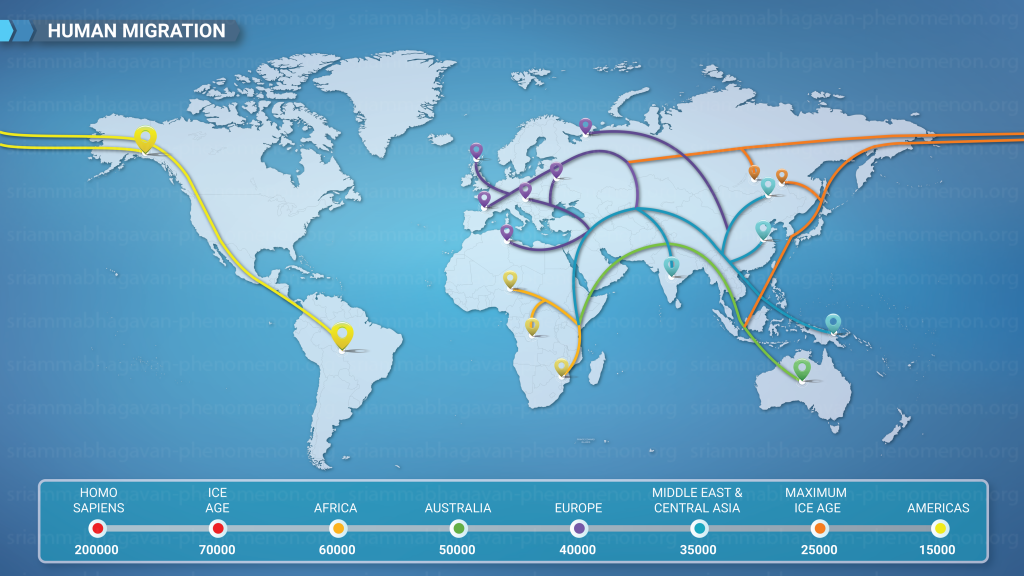
Evidence from archaeogenetics accumulating since the 1990s has led strong support to the ‘out-of-Africa’ scenario, and has marginalized the competing multiregional hypothesis, which proposed that modern humans evolved, at least in part, from independent hominid populations. While the results from archaeology, linguistics and genetics agree this is often not the case, however there is consensus today that small migrants of a few hundred people migrated across the Red sea.
Until 10,000 years ago, most humans lived as hunter-gatherers. They generally lived in small nomadic groups known as band societies. The advent of agriculture prompted the Neolithic revolution, when access to food surplus led to the formation of permanent human settlements, the domestication of animals and the use of metal tools.
Spread of Agriculture
For more than 2 million years our ancestors were nomadic hunter- gatherers. This changed for the first time about 11,500 years ago as Earth’s climate became warmer and milder.
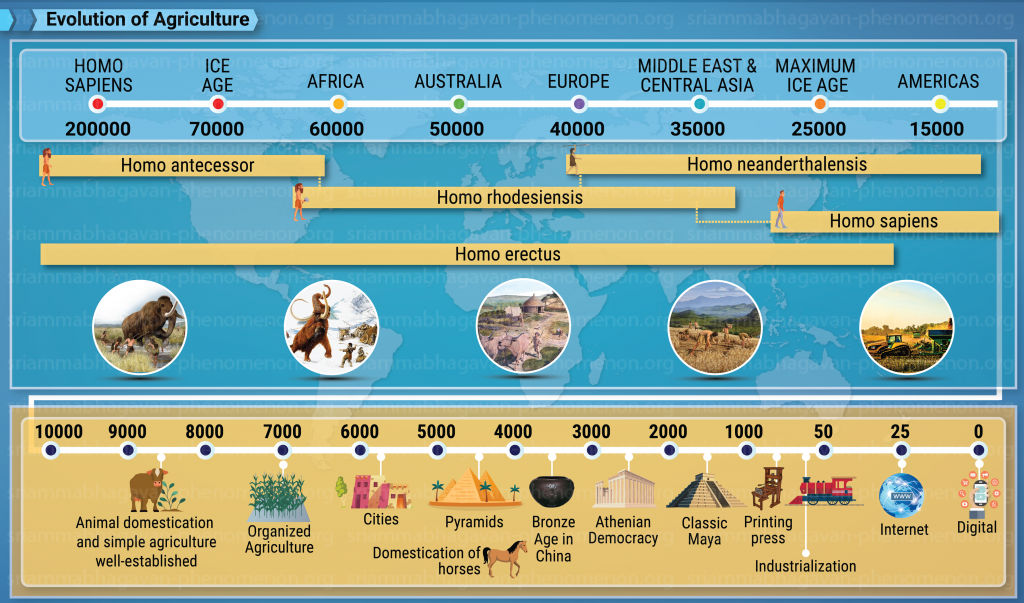
Scholars have developed several hypotheses to explain the historical origins of agriculture. Studies of the transition from hunter-gatherer to agricultural societies indicate an antecedent period of intensification and increasing sedentism; examples are the Natufian culture in the Levant, and the Early Chinese Neolithic in China. Current models indicate that wild stands that had been harvested previously started to be planted but were not immediately domesticated.
Localized climate change is the favored explanation for the origins of agriculture. When major climate change took place after the last ice age around 11,000 BC, much of the earth became subject to long dry seasons. These conditions favored annual plants which die off in the long dry season, leaving a dormant seed or tuber. An abundance of readily storable wild grains and pulses enabled hunter-gatherers in some areas to form the first settled villages at this time.
Mesolithic Age: 20,000- 10,000
Neolithic Period: 10,000 to now: Started taking nature into their control, domesticating animals, harvesting, settlement. During this period, the planet’s population exploded from 10 million to roughly 250 million.
Agriculture began independently in different parts of the globe, some of the earliest known domestications were of animals around 10,500 years
ago. It was not until after 9500 BC that the eight so-called founder crops of agriculture appeared.
Agriculture has profound implications on humanity and society, agriculture encouraged trade and cooperation, and led to complex society. First civilizations, about 6000 years ago, in few areas of intensive agriculture near the river valleys gave way to more complex societies in dispersed villages. Urban civilizations developed independently in four different areas of Eurasia.
People in the Middle East began experimenting with edible plants, selecting seeds from the best plants and planting them in protected areas. This type of gardening, called horticulture, required that people remain in one place to tend their crops, and gradually the nomadic lifestyle was replaced by more sedentary, permanent camps. Animals, too, were domesticated as companions, servants, or food sources. By about 10,000 years ago large permanent settlements like Jericho and Catalhoyuk appear in the archeological record. These “proto-cities” were not yet true cities but more like disorganized collections of villages with few signs of warfare, social stratification, wealth, rulers or any other levels of status. But another shift in human development on par with the Great Leap was in store.
By about 5200 years ago the first city-states appeared in several locations throughout the Middle East. For the first time the archeological record shows clear evidence of social stratification and a ruling elite holding almost all the wealth and power. This was the advent of civilization.
With the invention of writing human knowledge could be recorded permanently and controlled. Most of the characteristics of today’s world now appeared, including centralized government and power, military forces and warfare, institutionalized religion, patriarchy, monetary systems, poverty, large-scale agriculture, trade networks, and empire. Civilization soon appeared independently at many other locations throughout the world including China, India, Egypt, Peru, Crete, and Mexico. Not much of this has changed in the last 5000 years except the
names and places. But is this model still serving us well, or in humanity ready for something new, the next Great Leap?
In summary, humans have gone through major transformations from time to time. Transformation of human beings (more accurately certain groups of humans in certain areas) from hunters to fishers to agriculturists and from migratory to sedentary life constituting the most decisive revolution in the whole of human history. The climatic and ecological changes that made it possible have left their mark on the historical record down to the present day. From the closest history that we know, we see another phenomenal growth of the human population. One is agriculture made it possible and thought to have increased the population by 16 fold between 8000 – 4000 BC, it also gave rise to the familiar landscape of village communities and which even today prevails in many parts of the world. Second phenomenal growth contributed by industrial and knowledge industry and this gave rise to a population growth by almost seven fold from 1800 AD to today (population-count was approximately one billion in 1800 AD).
Throughout evolution, there have been challenges, numerous species have responded and survived. When they did not respond to challenges adequately, then they perished. That is why quite a number of species are extinct today. The human species till date responded to these challenges and they survived.
Sanathana Dharma to Civilizations and spread of Religions
Our environment is vital to our growth, civilizations are founded on fertile soil, clean drinking water and flowing rivers and the pollination of crops. This led to a next step in human evolution, the practice of living in a group with mutual understanding and dependency has become a very useful and practical lifestyle, and from small isolated groups, larger communities have formed. Initially humans lived collaborative with Nature and enjoyed freedom, at same time they did not destroy nature. Everyone followed eternal dharma, rules of Nature. Slowly, these are degenerated due to expansion of agriculture, settlements, civilizations, kingdoms, languages, culture, countries, enterprises, trade, and technology.
In the beginning there is nothing, we would call that as Shunya (Shu-Anya) or Shivam or Ekam or Nirguna Brahman or energy with all kinds of names. thing begins to vibrate with a certain frequency, this is the first manifestation, of course follows several kinds of vibration frequency. Everything in the Universe is vibration, there is nothing beyond a vibration. This is an energy dance. Even the smallest particle is energy dance. All particles are made up of these smaller particles. Energy can be still or silent, but the first manifestation of this energy is vibration, that is dancing Nataraja symbolizes. All this dance follows certain laws, these are mathematical laws. Other laws come much later, like laws of physics, chemistry, biology, organisms, human mind etc. In the very beginning, it is only a mathematical law and there is no creator, who created these mathematical laws. They self-existed, these are always eternal. These laws are called Dharma. These laws govern the Universe. These laws are called Nature’s laws. Everything is controlled by these laws and everything in this Universe can be reduced to these mathematical laws. It is not controlled by someone or some form as we believe.
The word “dharma” has multiple meanings depending on the context in which it is used. Monier-Williams’ Sanskrit-English Dictionary lists several, including: conduct, duty, right, justice, virtue, morality, religion, religious merit, good work according to a right or rule, etc. The English word religion is a little different from Sanatana-dharma. Religion conveys the idea of faith, and faith may change. One may have faith in a process, and he may change this faith and adopt another, but Sanatana-dharma refers to that activity which cannot be changed. In Buddhism, dharma is the doctrine, the universal truth common to all individuals always, proclaimed by the Buddha.
These laws of Sanathana Dharma are eternal and following these laws, Nature created platforms which support life forms. One such platform is the collective unconscious mind and this consists of programming, a collective learnings, like our Artificial Intelligence does..
While we use spiritual, Sanathana Dharma, Dharma, philosophical, religion very loosely and synonyms, but they are entirely different. Initially what was there is eternal dharma or Sanatana dharma across the entire humanity. As civilization grew, various personalities have influenced their respective groups or civilizations. Some have grown into faiths, cults, religions etc. According to Toynbee panoramic view, he counted 23 civilizations from ancient times to the present. Some of the oldest civilizations to have ever existed in the world. The following table lists the 23 civilizations identified by Toynbee. This table does not include what he terms primitive societies, arrested civilizations, or abortive civilizations.
| 1st Generation | 2nd Generation | Universal Church | 3rd Generation |
| Minoan | Hellenic (Greek and Roman) | Christian | Western; Orthodox-Russian; Orthodox-Byzantine |
| Syriac Society (Ancient Israel, Phoenicia etc.) | Islam | Islamic (at early stages divided into Iranian and Arabic, civilizations, which later were unified) | |
| Shang | Sinic (see also Han Dynasty) | Mahaya- na (Bud- dhism) | Chinese; Japanese-Korean (“Far Eastern”) |
| Indus | Indic | Hinduism | Hindu |
| Egyptiac | – | – | – |
| Sumeric | Hittite; Babylonian | – | – |
| Andean; Mayan; Yucatec; Mexican | – | – |
Very interesting aspect is, spirituality, philosophies, religions controlled the course of humanity in history rather than material forces. Only in the last few decades, material forces started dominating. Individuals played a creative (or destructive) role in the unfolding of events. Some of the individuals who played a creative role are : Saint Thomas Aquinas (1225- 1274), Aristotle(384-322 BCE), Confucius (551–479 BCE), René Descartes (1596–1650), Ralph Waldo Emerson (1803 – 1882), Michel Foucault (1926-1984), David Hume (1711–77), Immanuel Kant (1724–1804), Søren Kierkegaard (1813–55), Lao-Tzu (also Laozi, lived between the 6th and 4th century BCE), John Locke (1632–1704), Niccolo Machiavelli (1469–1527), Karl Marx (1818–83), John Stuart Mill (1806–73), Friedrich Nietzsche (1844–1900), Plato (428/427?–348/347? BCE), Jean-Jacques Rousseau (1712–78), Jean-Paul Sartre (1905–80), Socrates (470–399 BCE), Ludwig Wittgenstein (1889–1951)
Spread of Religions
In world cultures, there have been traditionally many different groupings of religious belief. Religion is a social-cultural system of designated behaviors, prophecies or organizations that relates humanity to supernatural or spiritual elements. However there is no scholarly consensus over what precisely constitutes religion.
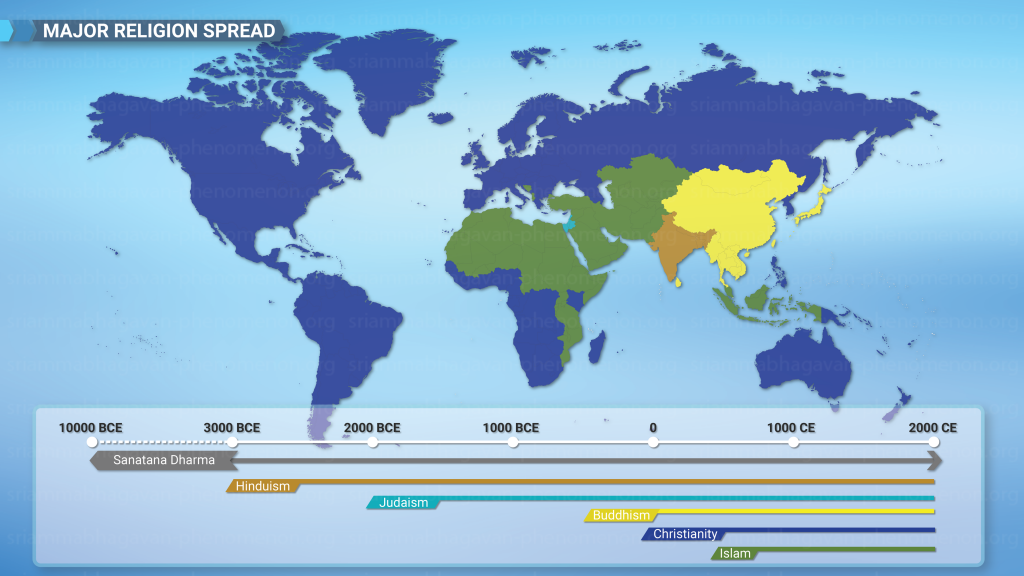
Major part of human history, there was no organized religion. What was there is just one and it is called Eternal Dharma (In Sanskrit – Sanathana Dharma). As time passed by, around 5000 years back, one of the ancient religions was named as Hinduism. Then followed other religions.
Many of these religions are Indian-origin like Hinduism, Jainism, Buddhism, and Sikhism, all of which are based on the concept of dharma and karma. In Indian culture, different religious philosophies were traditionally respected as academic differences in pursuit of the same truth. In Islam, the Quran mentions three different categories: Muslims, the People of the Book, and idol worshipers. Initially, Christians had a simple dichotomy of world beliefs.
Buddhism and Vedanta are two big schools which have dominated the spiritual world till date. Among many schools which have existed in the past, only these two have made a great influence all over the world and continue to exist. But they seem to be contradictory to each other in many ways. But based on my own experience and based on what I have read, these two schools only seem to differ because they use different conceptual languages. They also have different teaching methods. But the essence is the same.
When it comes to Vedanta, Prasthantrayi, consisting of main Upanishads, Brahma Sutras and Bhagavad gita is the authority. In Buddhism, Tripitaka, consisting of Vinaya Pitaka, Sutta Pitaka and Abidharama Pitaka, is the source of all conceptual details. When you go through the scriptures with an open mind and with the support of your own spiritual realization, you will see that both are essentially the same. Both schools talk about the cessation of suffering. The process of the cessation of suffering is called Moksha in Vedanta and Nirvana in Buddhism.
World’s principal religion and spiritual traditions may be classified into a small number of major groups as shown below. The population numbers by religion are computed by a combination of census reports and population surveys.
| Religion | Number of followers (in billions) | Cultural tradition | Founded |
| Christianity | 2.4 | Abrahamic reli- gions | Middle East |
| Islam | 1.9 | Abrahamic reli- gions | Middle East |
| Hinduism | 1.1 | Indian religions | Indian subconti- nent |
| Buddhism | 0.52 | Indian religions | Indian subconti- nent |
| Folk religion | 0.4 | Region dependent | All around globe |
In addition to above, there are many more medium – sized world religions, to name few are – Taoism, Shinto, Falun Gong, Sikhishm, Judaism, Confucianism,Spiritism,Korean Shamanism,Caodaism, Bahá’í Faith, Tengriism, Jainism, Cheondoism, Hoahaoism.
Interestingly, these numbers are not static, in the last three hundred years there has been a lot of change in numbers associated with specific religion. If we compare 200 years back and now, folk religions and other small religions have disappeared completely, and organized religions started taking the dominant positions.
Much of Spirituality, philosophies, religions emerged from Asia and specifically from Indian soil, we will see more details briefly on various phases of spirituality turned to various sects and “isms”, religions from this soil. We can speak of three of broad phases of evolution from Sanathana Dharma.
- Age of Rishis,
- Age of Teachers
- New Age Schools (Global Age)

Age of Rishis: Rishis, Munis, Sages of ancient India have revealed the knowledge. Whatever their wisdom, mystical experiences and revelations to them are their own spiritual realization. Later, all these collections are passed on in the form of Vedas, Upanishads etc. These Rishis expressed that everything is manifested from Brahman. Rishis were spiritual geniuses. But these revelations are very difficult to understand by common man. That is why so commentaries and independent texts later composed by great scholars and various Vedanta schools of thought emerged.
Age of Teachers: They used the knowledge of Rishis – Vedas and a comprehensive and systematic body of teaching. They did not blindly follow as we believe. They used scriptures, reason and experience are the proofs to validate. Vedanta is the interpretation of Upanishads mainly from Upanishads, Brahma sutras and Bhagavad Gita. There are mainly three schools of thought based on different interpretations. These are Adviata, Dviata, Vishishta-Advaita.
New Age Schools: There are quite many new age Vedanta schools in India, while there are so many new spiritual leaders emerged in last few hundred years and influenced modern India and to some extent world, all these can be related to any of above three and notable among them are
– Ramakrishna Paramahamsa and his disciple Swami Vivekananda and associated Vedanta Society a Western branch of the Ramakrishna Mission. Ramana Maharshi and his disciple H.W.L Poonja are inclined towards Advaita. Similarly, A. C. Bhaktivedanta Swami Prabhupada comes under new age who is the founder of ISKCON and inclined towards Dviata. on the other hand, the majority of Hindu temples follow Dvaita philosophy.
Let us look at who are all these main teachers and philosophies and their influence.
Advaita: GaudaPada and Adi Shankaracharya are considered the propagators of this philosophy. This is the oldest school of Vedanta, and it states that Brahman is the only reality and the world is illusory (Maya). Ignorance of the reality is what causes suffering, and liberation can be obtained only by true knowledge of Brahman. Gaudapada’s karika says The world never really emerged nor will it undergo any dissolution. There is really no one who’s bound, no one seeking enlightenment and no one who becomes enlightened. Advaita is only one form of Vedanta. It is just one of thousands of spiritual institutions in India, though certainly one of the largest.
Vishishtadvaita: This philosophy was pioneered by Ramanujacharya during the 11th century. Vishishtadvaita literally means the Unique Advaita, that is, Advaita with some amendments. It is midway between Advaita and Dvaita philosophies. God and the individual souls are inseparable, just like the fire and spark. In liberation, the Jivatma understands Paramatma, but does not merge in Paramatma.
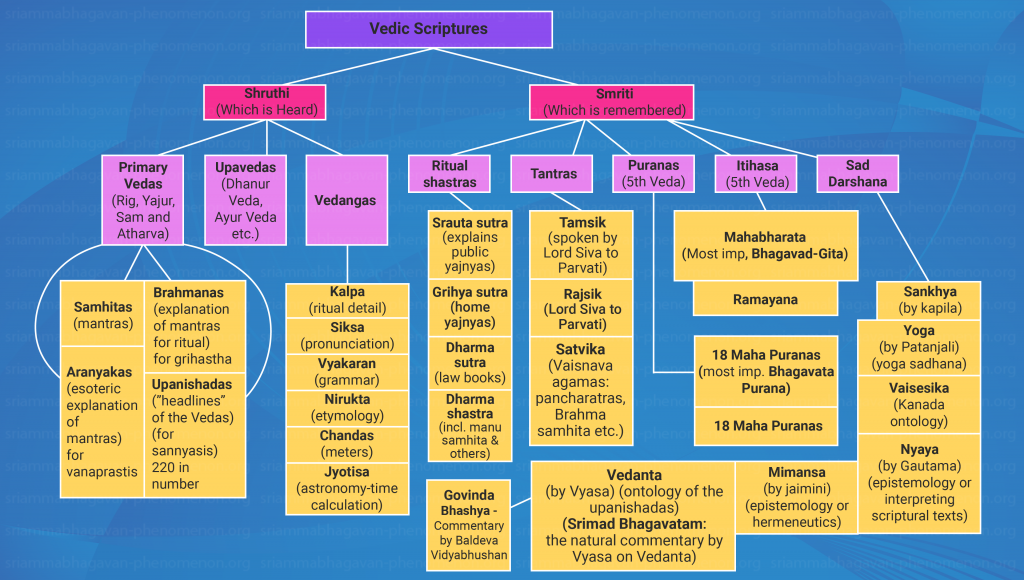
Dvaita: Madhvacharya propounded this philosophy. It considers Brahman and Atman as two different entities, and Bhakti as the route to eternal salvation. According to Dvaita, Jivatma are many and Paramatma is one. Concerning the soul Madhvacharya says that no two souls are alike. They each have different characteristics, different states of happiness/sorrow… the soul becomes similar to God in some respects when it is liberated, yet even in these respects it is much inferior to God.
In the final analysis, the above three philosophies are the different stages of spiritual evolution. No philosophy is inferior to the other. They feel that God is the controller of their life, God is different from them. Advaita philosophy exactly conveys the meaning of the Upanishads, Brahma Sutra and Bhagavad Gita. However, it is still popular among the highly spiritually evolved people. Many people are not aware of these three philosophies, but they worship God, in the manner they prefer.
| Vedanta | Propagator | Origin or Birth Place | Dates | Path |
| Advita | Adi Shanka- ra Charya | Kaladi in Kerala or Chidambar- am in Tamil- nadu | No clear agree- ment on DOB: 509 BC to 800 AD | Jnana Path |
| Vish- istaad- vita | Ramanuja Charya | Sriperum- budur, Tamil Nadu. | 1017–1137 AD | Devotion (Bhakthi) |
| Dviata | Madhva charya | Pajaka Kshet- ra, UDIPI | 1238–1317 AD | Devotion (Bhakthi) |
Vedas : The Vedas are a large body of texts originating in ancient India. Composed in Vedic Sanskrit, the texts constitute the oldest layer of Sanskrit literature.Veda, for orthodox Indian theologians, are considered revelations seen by ancient sages after intense meditation, and texts that have been more carefully preserved since ancient times. Who is the author?. There is no single author but many rishis (great sages) and their revelations for thousands of years as a declaration, just like for
Physics, Biology, Mathematics, Chemistry, there is no single author but many scientists are adding and contributing. All of them put together as Veda’s, Upanishads. According to tradition, Vyasa is the compiler of the Vedas, who arranged the four kinds of mantras into four Collections. These are four Vedas: the Rigveda, the Yajurveda, the Samaveda and the Atharvaveda. Each Veda has been sub classified into four major text types – the Samhitas (mantras and benedictions), the Aranyakas (text on rituals, ceremonies, sacrifices and symbolic-sacrifices), the Brahmanas (commentaries on rituals, ceremonies and sacrifices), and the Upanishads (texts discussing meditation, philosophy and spiritual knowledge). Some scholars add a fifth category – the Upasana’s (worship). A high level classification of Vedic Scriptures are shown below. However, most of the original scripts of Vedas are damaged or non-existent, what is available today is mostly interpreted.
Vedantha is philosophy based on Upanishads, depending upon interpretation of Upanishads, there are many schools of Vedanta. They present the highest philosophical teachings of Vedas, they are among the most ancient texts known to mankind. There are almost 108 Upanishads, among all of these around 11 are major ones, among these the smallest and toughest Upanishad is Mandukya Upanishad. For Liberation, those who want spiritual enlightenment, for Mukthi and Moksha, Mandukya Upanishad alone is sufficient. This Upanishad is found in Atharva Veda. In this Upanishad, there are only twelve mantras, again out of these twelve mantras, 7th Mantra is core of these Upanishad.
Mandukya Upanishad, seventh verse:
nāntaḥprajñaṃ na bahiḥprajñaṃ nobhayataḥprajñaṃ na prajñānaghanaṃ na prajñaṃ nāprajñam | adṛśya mavyavahārya magrāhya malakṣaṇamacintyamavyapa deśyamekātmap ratyayasāraṃ prapañcopaśamaṃ śāntaṃ śivamadvaitaṃ caturthaṃ manyante sa ātmā sa vijñeyaḥ || 7 ||
Meaning of above verse: Turīya is not that which is conscious of the internal (subjective) world, nor that which is conscious of the external (objective) world, nor that which is conscious of both, nor that which
is a mass all sentiency, nor that which is simple consciousness, nor that which is insentient. (It is) unseen (by any sense organ), not related to anything, incomprehensible (by the mind), uninferable, unthinkable, indescribable, essentially of the nature of Consciousness constituting the Self alone, negation of all phenomena, the Peaceful, all Bliss and the Non-dual. This is what is known as the fourth (Turīya). This is the Ātman and it has to be realized.
Vaishnavism is one of the major Hindu traditions, there are few more and notably, other three major traditions are, Shaivism, Shaktism and Smartism. These are sometimes referred to as the denominations of Hinduism, and they differ in the primary deity at the center of the tradition.
Please do not equate Vedanta with Sanatana Dharma. Vedanta is just one of the orthodox systems of philosophy within Sanatana Dharma . Hindus had never known they were “Hindus,” yet they had to be happy with this new designation; They had never called their view of the world a “religion” (a word with no equivalent in Sanskrit), but it had to become one, promptly labelled “Hinduism.” Nor was one label sufficient.
In Michel Danini words, “Religion is a Western concept; the Indian concept is neither religion nor even Hinduism nor any ‘ism’ — it is Sanatana Dharma, the eternal law of the universe, which cannot be formulated in any rigid and final set of tenets.”
While we respect this wisdom, Unfortunately, everyone portrayed that their philosophy or religion is great. It did not end there, the problem is they felt that their God is the only God. Looking back from the start of this chapter, if we look at a big picture, everything manifested from nothing and it took billions of years to come to the present state. Spread of human evolution, agriculture, religions, philosophies etc are a small fraction of time and how can one say that their religion or philosophy or faith is the only truth? How can we blindly follow any one and for that matter whom to follow is the big question? And we don’t even know by following any one of them, whether we can reach the real purpose of
our life? I will leave it to individuals at this stage!
Not portraying just on materialistic side and all is divisive. But at the same time many humans are experiencing oneness and, in their hearts, and high levels of consciousness. That is the proof of our philosophies, religions etc.
Spread of Economy, Money and Technology
Our ordinary history textbooks portray a very common sentence that we use regarding our ancestors is, “most of the time humanity spent in caves” and those were fundamentally living for biological needs and struggled for food, shelter and survival. However, I differ and concur with another spiritual teacher Krishna Ji and he says, for most part of human history, humans were living a communion life with nature. They spent long periods of quiet time and experienced high states of consciousness. There were great civilizations, much more advanced in terms of today’s technology 70,000 years ago as per our history it was before the ice age, but due to a huge volcanic eruption, all of those advanced civilizations have disappeared and humanity has started all over again.
Only in the last one to two millenniums, many slowly started losing direct touch with nature and started depending on some skills in various fields. Only in the last few thousand years they have experienced the domination of one field at a time like metal ages (bronze, copper, iron ages), then art, dance, music. Here the idea is not to say what sequence is right or wrong. rather, such fields are manifested across the planet and slowly a major part of humanity experiences it at the back end learning takes place and that field becomes like a commodity and then the next field comes in to play in further evolution. While above fields are taking a backseat.
As a part of evolution human being always tried to utilize his unique skills (brain power) that is provided by Nature or God to his advantage (either to support nature or against) from simple tools to hunt, fight or doing agriculture, spiritual, philosophical, physical power, industrial revolution through steam, mechanical power, electrical power, communication and information processing power. Humanity as a whole has witnessed continuous changes from time to time, especially in the last few hundred years we see rapid technological advances as shown in the picture below. Individual and nature disappeared and have gone to the background whereas centralized power houses in the form of institutes, business and kingdoms, governments took the front seat. These centralized organizations started influencing all fields of human life such as education, health care, political systems, trade, international policies etc.
Most part of the time our ancestor’s lived as cave man living in perfect coordination with nature. Whatever his needs are, fulfilled from nature when the need arises. There was no requirement for storage. Only in last 10,000 years, farming has started, humans started settling down and started domestication of animals and growing crops and storing the grains etc. This is one of the reasons, humans started distancing from nature. With the advent of gold currency and monetary systems, trading started that enabled humans to start producing to gain more accumulation of currency rather than based on need. This created trade, business, civilisations, kingdoms, governments and so on. In this process, man moved away from nature and surrendered to centralised powers. Slowly, our lives are taken over by these centralised systems and moved away from nature and we even started destroying the nature. If we are not emotional and intellectually understand one can realise Agriculture, Money and Religion are three things they contributed more negatively in humanity evolution comparative to positive side. Human population multiplied and expanded around the planet. Around 500 years ago humans interconnected physically on the planet through shipping, through trade, telegraphs, airplanes, communications and the internet.
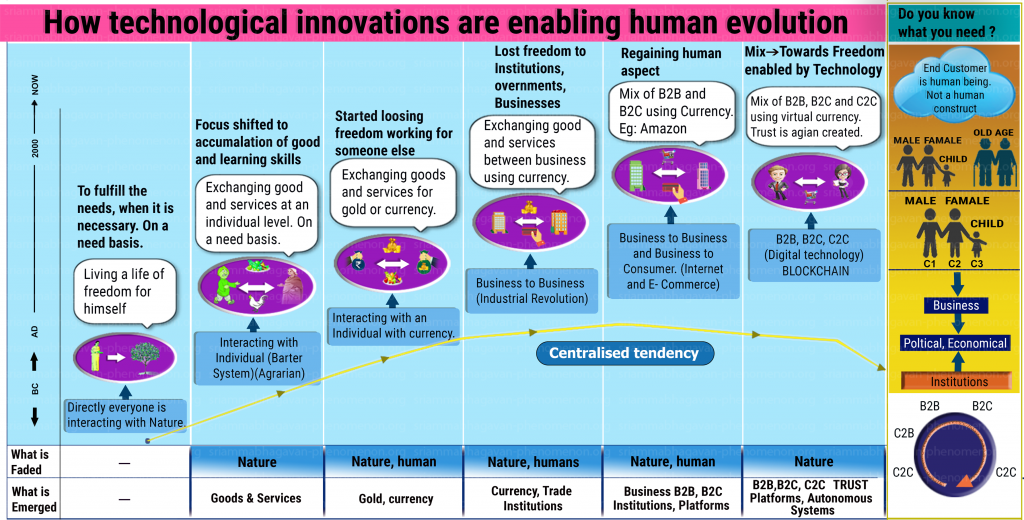
Technology Transformation
Especially a few hundred years back there was not much change in generation to generation. Our forefathers, their children and grandchildren lived more or less a similar life. But now it has accelerated so fast, especially in the last 70 years, just in a single generation, there have been so many technological advancements like Gene editing, AI, Robotics, quantum computing and so on. While this transformation is taking place, there will be chaos, stress and order in cycles. All of us are experiencing day by day ever increasing stress, uncertainty and chaos and great leap of technological advances putting us into question on redundancy of human activity that we have been doing at work, at family, at society, at hospitals, at schools, at government and all spheres of domain. This is causing us to experience our life as a struggle?
Chaos and stress
Without Chaos or disorder and stress, old cannot die and new cannot take birth, like a mother bringing her newborn on to this planet or a seed transforming into a plant, however after this chaos, stress, it settles down and order becomes prevailing. This goes in cycles and this is inevitable in the process of evolution. Otherwise, evolution by maintaining a continuous order or status quo will not progress further. It is a natural process and we have to have patience and cooperate and support Nature. Though stress is synonymous with a negative condition, a total stress-free life is not synonymous to growth and progress in an individual’s life. For any growth to happen, there must be a certain amount of pressure, to stretch beyond your normal capabilities. We can find pressure in every aspect of this creation leading to a newer form of existence. Universe is a movement and to move you need force or pressure. If there were no pressure, would water be absorbed from the soil by the roots? If there were no pressure, would a child be born? Stress is a pressure that nature or universe creates to push you to the next level of growth. Hence an optimal stress is always essential.
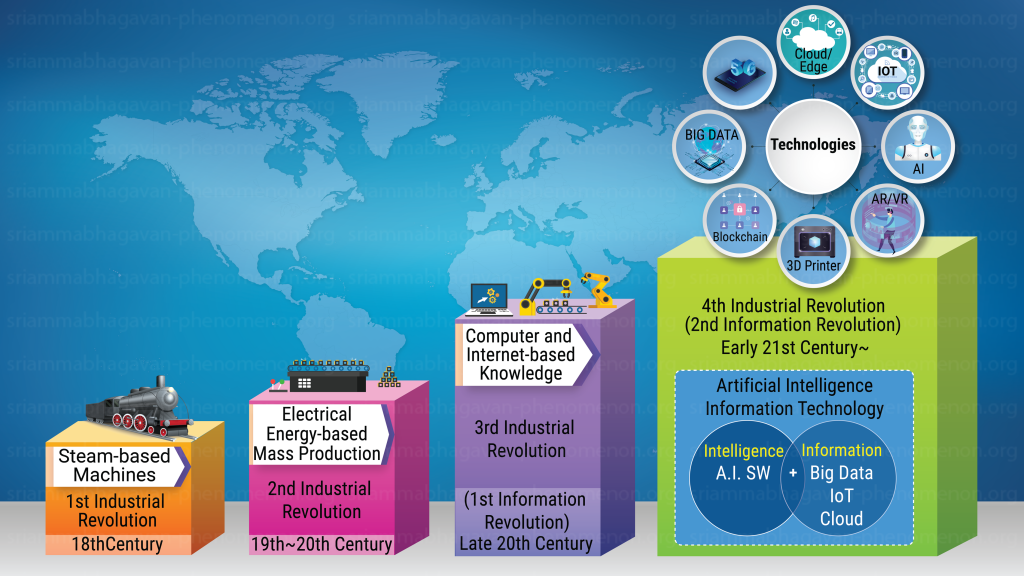
Let us start looking at what this chaos and stress can bring on the positive side. Throughout the evolution this chaos, stress, dis-order into order in cyclical nature are happening and this is not the first-time humanity is facing this. Instead of sitting on the ground floor and cribbing and suffering about this Universe and fearing about what will happen or this world would be doomed etc, One must go to a higher floor and see an Aerial view that will give the big picture and raise your Consciousness level. The Universe is basically unpredictable, because the Universe is a living thing and it is changing from moment to moment.
If we slow down our running mundane life or daily activities and start seeing the big picture, we understand there is a higher element.
Life is movement, an oscillation between order and disorder, light and shadow, the arising and ceasing. In the natural course of things, order as it moves towards disorder would move you away from Oneness towards a division. Chaos is always a precursor to a change in consciousness. Therefore, that every challenge comes in the form of disorder and division, it is beckoning us towards a great order and Oneness. There will be enormous stress during this transformation.
But today the curse of modern society is at immense psychological stress. And this is precisely because of a transitional shift happening from one civilization to another at a rapid pace. The emergence of the new and the termination of the old is creating great stress. There is an accelerated change in every sphere. People who are not able to adapt to the new are put through enormous stress. However, the demand of the hour is not only to equip yourself with new skills but also to work on the integration of the families. A healthy family system would certainly provide you the strength, the intelligence and an appropriate emotional state to withstand these challenging times. Therefore, focus on improving your family relationships.
Going back To sanathana Dharma, a holistic science
Air PolluTion, plastic waste, deforestation and so many other human activities are destroying our natural world, this is a direct threat to our future. In my view, we need to relook and question
some fundamental inventions whether they are needed to humanity like agriculture, money or currency and religion. Are these human activities aimed towards raising consciousness or just mere economical production? Humanity in ignorance, prioritizes the economy over nature. But if we destroy the planet, there is no economy. We are losing nature at a massive rate. House is on fire, we do not have much time.
We never realized or experienced as one single organism. It is not just humans but a complete species living on this planet. Intellectually people need to understand how they need to co-operate and behave for the Oneness. Humanity lived and created systems whether in education or sports or business for that matter any thing in life, it is based on an illusion of separate self and that manifested divisive nature in the outside world and competition as a mechanism to achieve.
Man’s quest by divisive nature has started many centuries ago, from Sanathana Dharma, One Dharma to many Dharma’s and many religions This divisiveness is not only to Dharma but spread across all human activities like arts, medical, legal, education and so on including on Matter to atoms.
In the name of intellect and science, we start to make dissecting everything, divide and try to know by this process. Dissection works with some things but not all aspects of life. We must differentiate to know what to dissect and what not to do. We started using the same tool for man-made things and nature made things like life. Life cannot be known by breaking it. Whole of modern science has evolved by breaking things. Our scientists still believe that by designing and installing genetic code like in synthetic biology, they can understand life and surprisingly spend billions of dollars on that. Including DNA sequences coupled with Artificial Intelligence Technologies for the health of our physical body. Still modern science is not viewing holistic beyond what is physically visible to either microscope or Telescope.
One must understand that it is not our fault, we are born into the world, where separation is the rule. Protecting an individual separate self is the rule (We will get into more details in the next chapter on what is this self ). Source of our suffering is separation from our true nature of Love. In the light of modern science it will be possible for us to see sanathana- dharma as the main occupation of all the people of the world. Dharma is more of Science than religion or it is close to Mathematical laws (Physical laws, Karmic Laws, Laws which govern life process and Universal processes comes later). It is about the betterment of human life individually or collectively. Sanathana means Timeless. When we speak of sanathana-dharma, we take this definition for granted. That which has neither beginning nor end is unlike anything sectarian, which has limits and boundaries. All others including religions, philosophies etc will stay for some time and die. Where Sanathana Dharma remains eternal.

